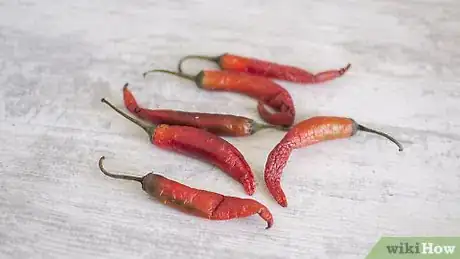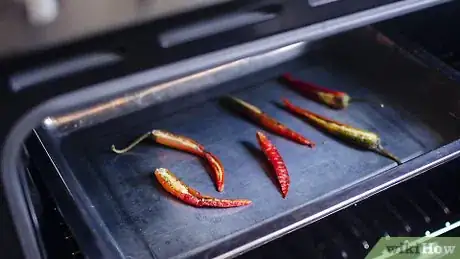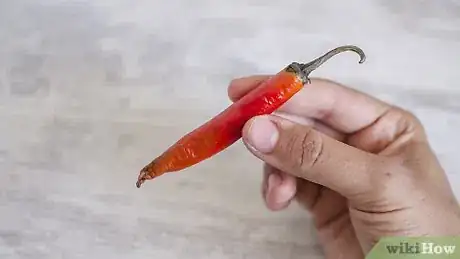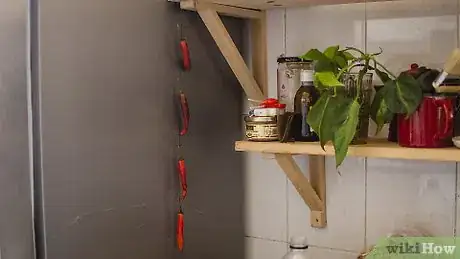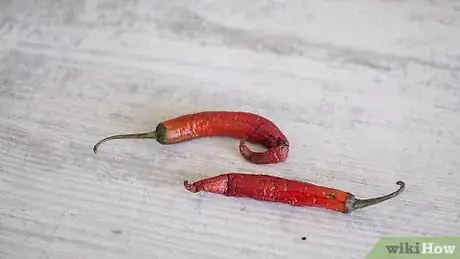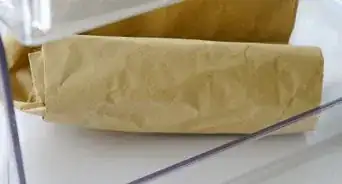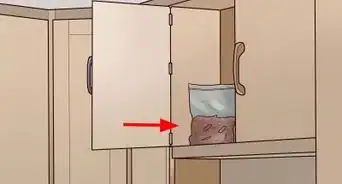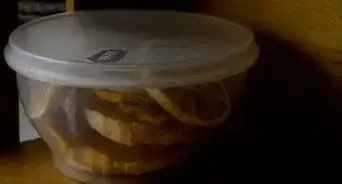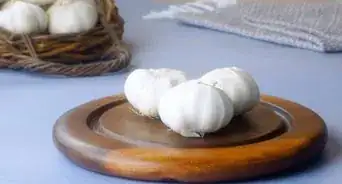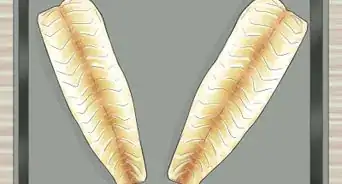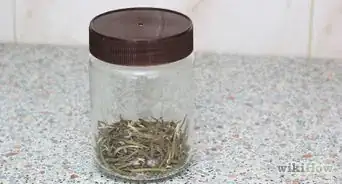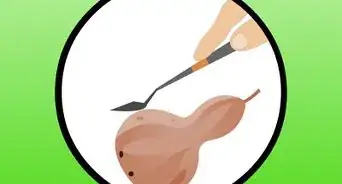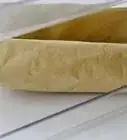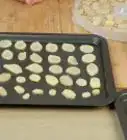This article was co-authored by wikiHow staff writer, Janice Tieperman. Janice is a professional and creative writer who has worked at wikiHow since 2019. With both a B.A. and M.A. in English from East Stroudsburg University, she has a passion for writing a wide variety of content for anyone and everyone. In her free time, you can find her working on a new crochet pattern, listening to true crime podcasts, or tackling a new creative writing project.
There are 7 references cited in this article, which can be found at the bottom of the page.
The wikiHow Video Team also followed the article's instructions and verified that they work.
This article has been viewed 21,175 times.
Learn more...
Chili peppers are well-known for their spiciness. While most peppers are naturally hot, they can become much hotter after the drying process. Although time-consuming, drying peppers is a simple way to take your spicy dishes to the next level of heat.
Steps
Drying in the Oven
-
1Check the peppers for quality. You will want to do this with each drying method, as this will help to make sure that your peppers are not rotten or bruised before they are dried. Take a moment to examine all of your peppers for any soft spots, oddly colored patches, or a stinky odor. Rinse all remaining peppers to remove any specks of dirt.[1]
-
2Slice the peppers into halves. Use a sharp knife to cut along the length of the pepper. This will allow for even amounts of heat to reach each pepper slice. [2]Advertisement
-
3Place the peppers in rows on a cookie sheet. Before placing them in the oven, space out the peppers along the cookie sheet. This will allow even amounts of air to reach each slice. [3]
-
4Preheat the oven to 135 °F (57 °C). While this may seem like a low temperature, it will prevent the peppers from cooking during the drying process. When you preheat the oven, open a window to make sure that there is plenty of air flowing in the kitchen and nearby rooms.[4]
- Depending on your oven, you can set the initial preheat temperature to be higher or lower than 135 °F (57 °C). The recommended threshold is 110 °F (43 °C) to 150 °F (66 °C). [5]
-
5Keep the oven door open a few inches. This will allow air to enter the oven while also allowing moisture from the peppers to leave. Feel free to move to a different room during the bulk of the drying process, as the open oven door will make the kitchen and neighboring rooms very warm.[6]
- If you have a convection oven that automatically allows for air flow, then you can disregard this step.[7]
-
6Rotate the peppers once per hour to make sure that all sides of the pepper are thoroughly dried. You can tell that a pepper is dry once it looks thin and leathery. [8] Keep the peppers in a tightly sealed container for storage.[9]
- Depending on the oven, this process can take anywhere from a few hours to several days. Only use this method if you will be home for an extended period of time. [10]
Air-Dry in Kitchen
-
1Make sure that the peppers are fresh. It is especially important to make sure that none of your peppers are rotted before exposing them to the air. Mushy spots, discolored areas, or a bad odor are all signs that a pepper should be discarded. Rinse all remaining peppers to remove any dirt.[11]
-
2Thread twine in a sewing needle through each pepper stem. In order to maintain even air flow, you should keep a distance of at least one inch between each pepper. If you don't have a sewing needle, you can knot the twine or string around the pepper stems to hang them. [12]
-
3
Using a Dehydrator
-
1Throw out all rotten peppers. Before dehydrating the peppers, you should check all peppers for weak spots, strange splotches of color, or a bad smell. Rinse all of the remaining peppers to clear away any excess dirt. [15]
-
2Cut the peppers into long pieces. Use a sharpened knife of your choice to make long, vertical cuts along each pepper. This will help to make sure that each pepper receives an even amount of air flow within the dehydrator.[16]
-
3Space out the peppers in the dehydrator. When placing the pepper pieces into the dehydrator, try to allow a gap between each pepper. This also helps to give each pepper piece an even amount of air.[19]
-
4Set the dehydrator to 135 °F (57 °C). Once you have assembled the peppers in the dehydrator, you can turn it on to begin the drying process. [20] Depending on the machine, it can take up to 24 hours for the peppers to be completely dry. You can check on the peppers once every few hours to see how fast they are drying. [21]
- Depending on the specific machine, you may want to set your dehydrator to a higher or lower temperature. Check your dehydrator's manual for specific instructions. [22]
-
5
Warnings
References
- ↑ https://www.scottrobertsweb.com/ultimate-guide-to-drying-hot-peppers/
- ↑ https://cedarcirclefarm.org/tips/entry/drying-peppers
- ↑ https://cedarcirclefarm.org/tips/entry/drying-peppers
- ↑ https://cedarcirclefarm.org/tips/entry/drying-peppers
- ↑ https://www.scottrobertsweb.com/ultimate-guide-to-drying-hot-peppers/
- ↑ http://www.homegrown.org/forum/topics/drying-chile-peppers-101-poblano-chipotle-serrano
- ↑ http://www.homegrown.org/forum/topics/drying-chile-peppers-101-poblano-chipotle-serrano
- ↑ https://momprepares.com/preserve-food-at-home-how-to-dehydrate-sweet-bell-peppers/
- ↑ https://www.scottrobertsweb.com/ultimate-guide-to-drying-hot-peppers/
- ↑ https://www.scottrobertsweb.com/ultimate-guide-to-drying-hot-peppers/
- ↑ https://www.scottrobertsweb.com/ultimate-guide-to-drying-hot-peppers/
- ↑ https://www.veggiegardener.com/threads/how-to-air-dry-peppers.1736/
- ↑ http://www.homegrown.org/forum/topics/drying-chile-peppers-101-poblano-chipotle-serrano
- ↑ https://cedarcirclefarm.org/tips/entry/drying-peppers
- ↑ https://www.scottrobertsweb.com/ultimate-guide-to-drying-hot-peppers/
- ↑ https://puregracefarms.com/fall-in-the-pantry/how-to-dry-peppers/
- ↑ https://www.scottrobertsweb.com/ultimate-guide-to-drying-hot-peppers/
- ↑ https://www.scottrobertsweb.com/ultimate-guide-to-drying-hot-peppers/
- ↑ https://puregracefarms.com/fall-in-the-pantry/how-to-dry-peppers/
- ↑ https://momprepares.com/preserve-food-at-home-how-to-dehydrate-sweet-bell-peppers/
- ↑ https://puregracefarms.com/fall-in-the-pantry/how-to-dry-peppers/
- ↑ https://momprepares.com/preserve-food-at-home-how-to-dehydrate-sweet-bell-peppers/
- ↑ https://cedarcirclefarm.org/tips/entry/drying-peppers
- ↑ https://puregracefarms.com/fall-in-the-pantry/how-to-dry-peppers/
- ↑ https://cedarcirclefarm.org/tips/entry/drying-peppers
- ↑ https://www.alimentarium.org/en/magazine/infographics/scoville-scale
